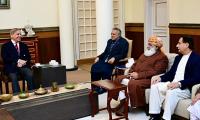As Pakistan limps towards the formation of a new government following last week’s unexpected surprises in parliamentary elections, the future is set to be driven by recurring political turbulence and uncertainty.
The new ruling coalition – and it is certain to be a coalition – will likely remain under pressure and pulled apart by its members, each armed with a narrow set of self-interests distinct from the other.
Ultimately, is Pakistan already set for its next parliamentary elections to be held much sooner than planned in 2029? To that compelling question, the answer for now must come with a very heavy dose of ‘affirmative’.
The consequence of the emerging ‘half’ a rule will be multifaceted for the future of Pakistan, though eventually the country’s mainstream population will likely suffer.
In the closing days of the election campaign, two messages from former Prime Minister Nawaz Sharif immediately stated the obvious. As Pakistan’s mainstream population suffered from the worst inflation in the country’s history just this past year, Sharif publicly promised a fancy urban transport project for Faisalabad followed by a promised train for a high-altitude destination, Murree.
Together, Sharif’s message was a powerful reminder of his past obsessions. At worst, however, it was a powerful reminder of Pakistan’s tragic economic history driven by fanciful choices, while critical elements notably the quality of healthcare and education alongside the quality of human resources all received mere lip service.
To make matters much worse for the national unity of Pakistan, bluntly put, Sharif’s choices have routinely focused on his home province – Punjab – while ignoring other areas of Pakistan notably those with pitiful living conditions.
Going forward, a government involving Sharif’s PML-N is set to press for more of the same — expensive transport projects in contrast to urgently tackling the crisis of hunger that increasingly engulfs Pakistan today.
And a return to the days of 'Darnomics' with former finance minister Ishaq Dar leading the finance ministry will only spell disaster for Pakistan at a delicate time in the nation’s history.
Just in his last tenure under the PDM government, then-finance minister Ishaq Dar (whose claim to fame remains his close family relationship with Nawaz Sharif) oversaw a stubborn deadlock in Pakistan’s ties with the IMF, the critical lender. Ultimately, former prime minister Shehbaz Sharif was pressed to urgently reach out to the IMF to arrange an emergency loan, just to keep Pakistan afloat.
In contrast, the PPP led by the young and energetic Bilawal Bhutto Zardari campaigned hard before last week’s elections, and promised to usher in a new era for Pakistan. But going forward, constrained by restrictions under the next IMF loan, delivering those promises will be difficult.
Though forced to join hands together under the immense weight of circumstances, the PML-N and the PPP are likely to face an increasingly uncertain future together. Their unity, should that happen, will only be the consequence of facing a common enemy, the PTI led by jailed leader Imran Khan, whose electoral victories have stunned even his worst critics.
In the unfolding future, a new government may turn to choices such as forcing banks to give out loans to controversial projects such as funds for another taxi scheme or even forcing banks to lend for home-based solar generation schemes. In view of Pakistan’s history, neither will be advisable.
Pakistan’s senior bankers still retain troubled memories of being forced under elected governments to give out large-scale loans under populist schemes, all practically without collateral. Such schemes are doomed to fail yet again, saddling banks with prospectively enormous new bad debts.
Past troublesome memories that will only reinforce the dangerous downside risk of such loans include accounts of luxurious cars sold in Pakistan under Nawaz Sharif’s yellow cab scheme eventually plying around roads across Afghanistan next door. On other fronts, both the PML-N and the PPP used similar schemes for tractors to win political favours.
In a complete break from the past, a future government must focus on a two-tiered target for the future of Pakistan. On the one hand, there must be a nationwide consensus followed by a nationwide crackdown to urgently focus on reforming Pakistan’s largely defunct tax collection system. The reality of less than two per cent of Pakistan’s population of 240 million being registered as taxpayers says much about how the country’s valuable resources continue to be squandered.
On the other hand, there must be a dramatic and forceful push to visibly cut wasteful expenditure by the state of Pakistan and its institutions. Unless the people of Pakistan visibly witness a complete change in the lifestyles of the rich and famous, notably their ruling elite, the visibly lagging popular confidence in the state and its institutions will not be restored.
The most compelling message from last week’s elections must not be ignored – that the people of Pakistan are unwilling to be ruled as before.
The writer is an Islamabad-based journalist who writes on political and economic affairs. He can be reached at: farhanbokhari@gmail.com
Many people believe that in future, AI will play an even more significant role in their lives
In April 2024, three Chinese and one Belarusian company were sanctioned for exporting missile-enabling technology to...
Pakistan has second highest neonatal mortality in world; in education sector, country's 26 million kids are out of...
Key actors in global power politics are US, China, Russia, European Union, and emerging powers such as India and Brazil
Maulana Fazl manages to bring together factions that historically stand opposed
NASA says August 2024 set new monthly temperature record, capping Earth’s hottest summer since 1880







